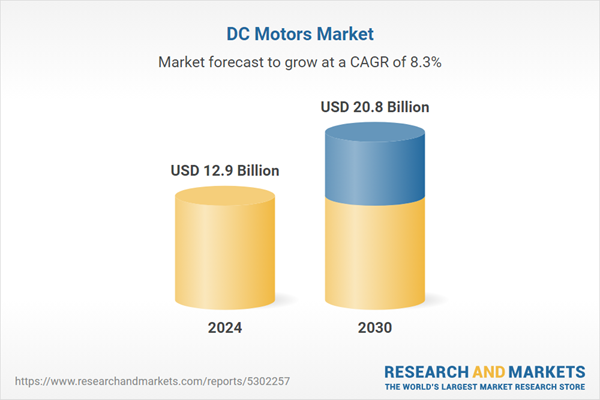Global DC Motors Market - Key Trends and Drivers Summarized
What Are DC Motors and How Do They Function?
Direct current (DC) motors are electric motors that convert electrical energy from a direct current (DC) power source into mechanical energy, producing rotational motion that drives various mechanical systems. The fundamental components of a DC motor include a stator, rotor (or armature), and a commutator. The stator creates a constant magnetic field, while the rotor, connected to the power source, acts as an electromagnet. When a DC current flows through the rotor windings, it generates an electromagnetic force that interacts with the stator's magnetic field, causing the rotor to spin. The commutator plays a crucial role by reversing the direction of the current at precise intervals to ensure continuous rotation in a single direction. This simple yet effective design allows DC motors to provide smooth, precise control over speed and torque, making them highly suitable for applications that require variable speed and exact positioning. There are different types of DC motors, such as brushed, brushless, shunt-wound, and series-wound, each tailored to meet specific operational needs. Brushed DC motors, which use brushes and a commutator to transmit current, are typically used in smaller applications like toys, power tools, and small appliances due to their straightforward design and low cost. Brushless DC motors, on the other hand, replace the mechanical commutator with an electronic controller, offering higher efficiency, longer lifespan, and reduced maintenance, making them ideal for high-performance systems like drones, electric vehicles, and industrial machinery. The ability to provide reliable, controllable, and efficient motion underpins the broad utility of DC motors across multiple sectors.Why Are DC Motors Preferred Across a Wide Range of Industries?
The widespread use of DC motors in diverse industries is driven by their excellent controllability, high torque output, and adaptability to various power requirements. In industrial automation, DC motors are a key component in motion control systems, providing precise positioning and speed regulation for conveyor belts, robotic arms, and automated production lines. Their ability to start, stop, and reverse direction quickly makes them ideal for tasks that require rapid response and accurate motion. In transportation, DC motors are extensively used in electric vehicles (EVs), where their high torque at low speeds contributes to smooth acceleration and enhanced driving performance. Brushless DC motors, in particular, are favored in EVs and hybrid vehicles due to their high efficiency and compact size, which help maximize battery life and vehicle range. DC motors are also found in consumer electronics, where their compactness and low noise operation are valuable for powering fans, CD drives, and small appliances. Additionally, they play a crucial role in aerospace applications, powering actuators, pumps, and control systems that demand reliable and lightweight solutions. In the renewable energy sector, DC motors are employed in wind turbine control systems and solar tracking mechanisms to optimize energy capture. Their precise speed and torque control are essential for adjusting the positioning of blades and panels in response to changing environmental conditions. The versatility of DC motors, combined with their ease of integration and control through simple electronic circuits, makes them indispensable in applications ranging from household gadgets to complex industrial systems.What Innovations Are Transforming the DC Motor Industry?
The DC motor industry is undergoing significant transformation due to a series of technological innovations aimed at enhancing performance, efficiency, and reliability. One of the most notable advancements is the development of high-efficiency brushless DC (BLDC) motors, which eliminate the need for mechanical brushes and commutators. Instead, they use electronic controllers to regulate the current, resulting in reduced friction, lower heat generation, and minimal wear. This design extends the lifespan of the motor and improves its energy efficiency, making BLDC motors particularly suitable for applications where long operational life and high power efficiency are paramount, such as electric vehicles and medical devices. Another key innovation is the integration of smart motor technology. Modern DC motors are being equipped with embedded sensors, microcontrollers, and connectivity features that allow for real-time monitoring, self-diagnostics, and predictive maintenance. These smart motors can communicate operational data, such as speed, torque, and temperature, to central control systems or mobile devices, enabling optimized performance and early detection of potential issues. This level of intelligence is crucial for industries like manufacturing and robotics, where downtime can be costly and system precision is critical. The use of advanced materials, such as rare earth magnets and lightweight composites, is also enhancing the power-to-weight ratio of DC motors, enabling the production of smaller, more powerful units that are ideal for portable devices and high-speed applications. Additionally, innovations in power electronics, such as the use of wide-bandgap semiconductors, are allowing for more efficient and compact motor controllers, further boosting the performance of DC motors.What Factors Are Driving the Growth of the DC Motor Market?
The growth in the DC motor market is driven by several factors, including the increasing demand for energy-efficient solutions, the expanding adoption of electric vehicles, and the rise of automation across industries. One of the primary drivers is the global push for energy conservation and efficiency. As industries and consumers become more conscious of energy consumption and environmental impact, there is a growing preference for high-efficiency motors that reduce power usage and carbon emissions. Brushless DC motors, in particular, are gaining popularity due to their superior efficiency and lower maintenance requirements compared to traditional brushed motors. This trend is further supported by government regulations and standards aimed at promoting the use of energy-efficient technologies in both industrial and residential sectors. The rapid growth of the electric vehicle (EV) market is another significant factor propelling demand for DC motors. EV manufacturers are investing heavily in advanced motor technologies to enhance vehicle performance, increase driving range, and reduce overall system costs. DC motors, especially brushless variants, are integral to the development of efficient and reliable powertrains for EVs, making them a critical component in the transition towards sustainable transportation. The rise of automation and robotics in manufacturing, logistics, and healthcare is also contributing to the increased use of DC motors. Their precise control, compact size, and high torque output make them ideal for powering robotic arms, conveyors, and precision tools in automated environments. Additionally, the growing trend of miniaturization in electronics and medical devices is driving demand for smaller, high-performance DC motors that can deliver reliable performance in constrained spaces. Technological advancements, such as the integration of smart features and improved materials, are further enhancing the appeal of DC motors by offering greater durability, efficiency, and control capabilities. Together, these factors are driving robust growth in the DC motor market, positioning it as a key enabler of innovation across a wide range of industries.Report Scope
The report analyzes the DC Motors market, presented in terms of market value (US$ Thousand). The analysis covers the key segments and geographic regions outlined below.- Segments: Application (Pumps, HVAC, Compressors, Refrigeration, Fans, Material Handling, Material Processing).
- Geographic Regions/Countries:World; United States; Canada; Japan; China; Europe (France; Germany; Italy; United Kingdom; Spain; Russia; and Rest of Europe); Asia-Pacific (Australia; India; South Korea; and Rest of Asia-Pacific); Latin America (Argentina; Brazil; Mexico; and Rest of Latin America); Middle East (Iran; Israel; Saudi Arabia; United Arab Emirates; and Rest of Middle East); and Africa.
Key Insights:
- Market Growth: Understand the significant growth trajectory of the Pumps Application segment, which is expected to reach US$5.1 Billion by 2030 with a CAGR of a 9.1%. The HVAC Application segment is also set to grow at 9.6% CAGR over the analysis period.
- Regional Analysis: Gain insights into the U.S. market, valued at $3.3 Billion in 2024, and China, forecasted to grow at an impressive 12% CAGR to reach $5.1 Billion by 2030. Discover growth trends in other key regions, including Japan, Canada, Germany, and the Asia-Pacific.
Why You Should Buy This Report:
- Detailed Market Analysis: Access a thorough analysis of the Global DC Motors Market, covering all major geographic regions and market segments.
- Competitive Insights: Get an overview of the competitive landscape, including the market presence of major players across different geographies.
- Future Trends and Drivers: Understand the key trends and drivers shaping the future of the Global DC Motors Market.
- Actionable Insights: Benefit from actionable insights that can help you identify new revenue opportunities and make strategic business decisions.
Key Questions Answered:
- How is the Global DC Motors Market expected to evolve by 2030?
- What are the main drivers and restraints affecting the market?
- Which market segments will grow the most over the forecast period?
- How will market shares for different regions and segments change by 2030?
- Who are the leading players in the market, and what are their prospects?
Report Features:
- Comprehensive Market Data: Independent analysis of annual sales and market forecasts in US$ Million from 2024 to 2030.
- In-Depth Regional Analysis: Detailed insights into key markets, including the U.S., China, Japan, Canada, Europe, Asia-Pacific, Latin America, Middle East, and Africa.
- Company Profiles: Coverage of players such as Addison Electric, Inc., Amer Group, AMETEK Airtechnology Group, AMETEK Dynamic Fluid Solutions, Ametek MAE and more.
- Complimentary Updates: Receive free report updates for one year to keep you informed of the latest market developments.
Some of the 13 companies featured in this DC Motors market report include:
- Addison Electric, Inc.
- Amer Group
- AMETEK Airtechnology Group
- AMETEK Dynamic Fluid Solutions
- Ametek MAE
- Angst+Pfister Sensors and Power AG
- Assun Motors Pte Ltd.
- AutomationDirect
- BDI USA
- Bernio Elettromeccanica Snc
This edition integrates the latest global trade and economic shifts into comprehensive market analysis. Key updates include:
- Tariff and Trade Impact: Insights into global tariff negotiations across 180+ countries, with analysis of supply chain turbulence, sourcing disruptions, and geographic realignment. Special focus on 2025 as a pivotal year for trade tensions, including updated perspectives on the Trump-era tariffs.
- Adjusted Forecasts and Analytics: Revised global and regional market forecasts through 2030, incorporating tariff effects, economic uncertainty, and structural changes in globalization. Includes historical analysis from 2015 to 2023.
- Strategic Market Dynamics: Evaluation of revised market prospects, regional outlooks, and key economic indicators such as population and urbanization trends.
- Innovation & Technology Trends: Latest developments in product and process innovation, emerging technologies, and key industry drivers shaping the competitive landscape.
- Competitive Intelligence: Updated global market share estimates for 2025, competitive positioning of major players (Strong/Active/Niche/Trivial), and refined focus on leading global brands and core players.
- Expert Insight & Commentary: Strategic analysis from economists, trade experts, and domain specialists to contextualize market shifts and identify emerging opportunities.
Table of Contents
Companies Mentioned (Partial List)
A selection of companies mentioned in this report includes, but is not limited to:
- Addison Electric, Inc.
- Amer Group
- AMETEK Airtechnology Group
- AMETEK Dynamic Fluid Solutions
- Ametek MAE
- Angst+Pfister Sensors and Power AG
- Assun Motors Pte Ltd.
- AutomationDirect
- BDI USA
- Bernio Elettromeccanica Snc
Table Information
| Report Attribute | Details |
|---|---|
| No. of Pages | 166 |
| Published | January 2026 |
| Forecast Period | 2024 - 2030 |
| Estimated Market Value ( USD | $ 12.9 Billion |
| Forecasted Market Value ( USD | $ 20.8 Billion |
| Compound Annual Growth Rate | 8.3% |
| Regions Covered | Global |









